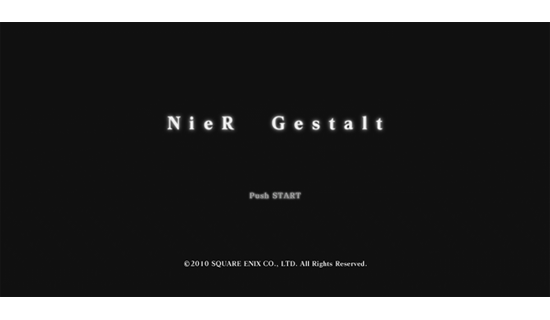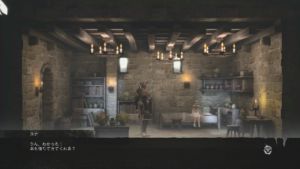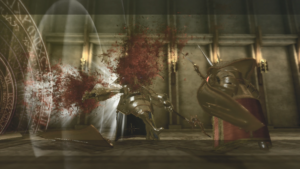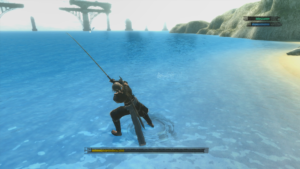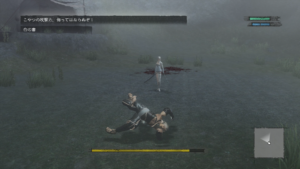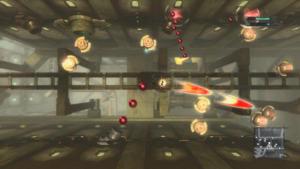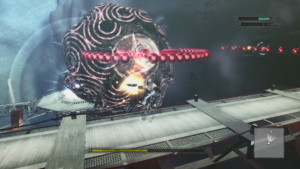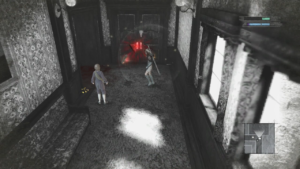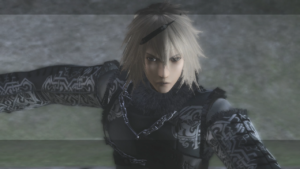Back in 2003, Drag-On Dragoon/Drakengard was a divisive release: It had a very layered and intriguing story, but badly implemented Dynasty Warriors-esque gameplay that just couldn’t support it. It had many different endings that that were unlocked by fulfilling various requirements, the last one (ending E) being particularly odd. But it was the events of that odd ending that would lead into 2010’s Nier. Though it doesn’t take place in what you might think of as the Drakengard universe, the situation in the world of Nier is a direct result of Drakengard’s E ending. In-game story details to support this wouldn’t really come about until the DLC, but the pieces are there from the start. The Japanese slogan was “一人のために、全てを滅ぼせ” or “Destroy everything, all for the sake of a single person”.
In Japan, Nier was released in two variations: Replicant and Gestalt. Replicant was released for the PlayStation 3 and features a young boy as the main character. Gestalt was released for the XBox 360 and features an older man as the main character. Originally the game was developed as the Replicant version, but Square Enix producer Yousuke Saito wanted a game that would be marketable in the west as well. This resulted in a slight retooling of the game to feature an older main character, and the subsequent split into two different versions for Japan (since director Yoko Taro still wanted to tell the original version of his story). Western countries only got the Gestalt version on both console platforms, and it was simply titled “Nier”.
Nier takes place 1300-1400 years after the events of Drakengard’s E ending, and on its surface is a story of our main character (sometimes referred to as Nier, though the player does get to enter a name for him) and sister/daughter (depending on which version of the main character you are) Yonah living together in a small village, and dealing with an illness known as the Black Scrawl that is worsening Yonah’s condition by the day. The first half of the game is focused on our main character embarking on various quests not only to help find components for medicines to ease Yonah’s sickness, but also to help out the people of the village and nearby areas, since that’s his main source of income. The world outside of these populated areas is home to monstrous beings known as Shades, which are often a source of difficulty for the normal people. Eventually the leader of the Shades is revealed: Maou (which interestingly is a fairly generic Japanese term for an evil lord or king), or The Shadowlord. This leads into the second half of the game in which Yonah is abducted, and the world’s Shade population grows immensely.
Along the way we also meet supporting characters Kaine and Emil. Kaine is a fiery and foul-mouthed lady fighter who is also possessed by a Shade, feeding off of her hatred brought about by her tragic background. Kaine’s costume design is very bad, but thankfully she’s also arguably the strongest and most interesting character in the game to make up for it. Emil is a magic-using boy that lives with a butler in an old creepy mansion (that is obviously a tribute to the Spencer mansion from Resident Evil), and is forced to constantly wear a blindfold since anything he looks at is immediately turned to stone and paralyzed. There’s much more to Emil than there appears to be though.
If you only play through the game once, the ending you see is very much a resolution of what seems to be the central conflict of the game. But much like Drakengard, there are multiple endings to be seen here. Unlike Drakengard, they aren’t really different endings based on different actions or paths taken, but rather the same series of events with more detail filled in and from different perspectives (with the notable exception of a choice you need to make that is the difference between endings C and D). This is how the real story is revealed.
Though the story as a whole is a very intriguing one (and there is a ton of lore that you can dive into by making connections from other Drakengard games, reading additional material found in the Japanese only strategy guide, etc.), but for me it was all about how well the little moments were written, and how themes were conveyed through them. A son discovers that his mother died in the process of leaving him behind to start a new life, and he shows understanding because she’s also just a person with her own desires, and her own capacity to make mistakes. A conversation between the main character and Grimoire Weiss then reminds us that there are so many different ways of viewing the world, and just because we don’t agree with them doesn’t necessarily make them wrong. There’s also a point where the main character invites Kaine to stay and live with him and Yonah, and the pained expression on her face for just a moment as she almost accepts is very affecting. These things could have been done in such bad and ham-fisted ways, but they weren’t. The story is ripe with tragedy, but it’s often in service of themes. And it even naturally builds upon one the main themes of the original Drakengard: how blood-thirsty can a “hero” be in the name of saving a single person important to him, without being a homicidal maniac?
But after what Drakengard turned out to be, it’s no surprise that Nier has a great story. This time around the gameplay also got a major improvement, as well as some variation. Nier is still primarily an action RPG, but now the battlefield is no longer literal battlefields full of enemies: Things are much more focused, making this feel a lot less like a bad Dynasty Warriors game. A lot of people seem to think that Nier has bad combat. I found it to be pretty average for an action RPG though, nothing more and nothing less. The lack of health drops also don’t prove to be a major problem like they were in Drakengard. There are two ways to fight: Melee weapons (only swords for the first half of the game, though great swords and spears open up as options in the second half) and magic. While there are a handful of spells that can be used to achieve different types of effects and attacks, the magic is here primarily to fill Yoko Taro’s desire to make a shoot-em-up game. Not only can you choose to fight enemies from a distance with your own shots, but many enemies will also rain bullets down upon you as well. Some of them will produce bullets in incredibly complex patterns that require you to weave in between or jump over them, incorporating elements from a bullet hell style shooter. Dodging some of the patterns (which are relatively mild compared to those found in actual bullet hell shooters) is often more difficult than it might seem due large character hit boxes and less rigid movement than in a shooter, but it’s an incredibly innovative idea that I think really works well. It makes a lot of the boss fights, which are often against suitably large and monstrous creatures, even more grand in feel when you see them spitting out waves of bullets at you and have to think about how best to deal with them.
But the shoot-em-up isn’t the only other genre that Nier pulls from. Every now and then the game will switch from 3D into a 2D side view. Sometimes this is just used used when entering buildings (like the main character’s house), but other times it’s a sign that it’s time to do some platforming. While the novelty of switching views like this is neat for aesthetic purposes, Nier would have been just fine without requiring any of the actual platforming. The controls are far too fiddly to play it straight like you would in a normal platformer, and I had to resort to double jumping and using that to position myself where I wanted to land. El Shaddai would come along a year later and do this same thing far better.
The integration of the visual novel genre was a more successful one. Kaine’s heart wrenching backstory is told in visual novel form on the second play through, but some particularly unique moments happen in an area called the Forest of Myth outside of that. The residents are all afflicted by the Deathdream, brought about from a giant tree in the village known as Sleeping Beauty. When in the Deathdream, one can only see and speak through text, making for a very good fit for a sequence of visual novels. I think this is one of the coolest concepts in Nier, because the thought of it is actually pretty horrifying, and that’s played out in the game. They’re some of the most surreal moments that Nier has to offer, and the characters talk about how horrible their first experience in the Forest of Myth was when returning to it later in the game. That said, the second visit makes a very bad design decision: gating your progress by forcing you to regurgitate a couple of facts from the text of the story that are randomized between three different possible options each time the story starts. They’re facts that you normally wouldn’t pay all that much attention to (one is a color, and one is a number), which is what makes this so ridiculous. If you answer incorrectly, you’re forced to go through the story again from the beginning. Once again, there is another RPG that did this integration with the visual novel slightly better: Lost Odyssey, in 2007.
If you prefer to have lots of non-combat stuff to do in your RPGs, Nier has you covered there too! It features systems for both fishing and harvesting, both of which are required for certain trophies/achievements and side quests as well. Harvesting takes place in the garden plot outside of the main character’s house (it’s unlocked through a couple of side quests), and serves the purpose of giving you access to materials that would otherwise be very costly in exchange for time and patience. Once you get into the more rare materials, there’s an aggregating amount of randomness involved too. Fishing is…well it’s not exactly as intuitive as you would expect fishing in a game to be. But it seems that Yoko Taro is a big fan of fishing in JRPGs, which explains why he regularly includes it as an activity in his games. I didn’t engage with either of these systems very much, but they’re around if you just can’t get enough or are a completionist.
A DLC pack called “The World of Recycled Vessel” was released approximately one month later, and allows you to play as the opposite version of the main character than the one that is featured in your version of the game. It also offers the opportunity to earn additional costumes and weapons through series of very challenging combat trials. It’s basically Nier for super players, so if you’re not big into/very good at the combat, you may want to stay away from this one. In terms of story, you really only get pieces of text in between trials that go into some details about how we got from the events of Drakengard ending E to here. It also features amazing techno arrangements of existing songs from the Nier soundtrack.
It’s not a unique opinion that the soundtrack and sound design are maybe Nier’s highest point, but it really can’t be overstated. The extremely atmospheric soundtrack was composed by Keiichi Okabe, along with other members of Studio Monaca (Kakeru Ishihama and Keigo Hoashi). The soundtrack was written largely independently from the development of the game, and apparently some elements of the game were actually modified to match the soundtrack (things would usually go the other way around). Lyrics and vocals were provided by Emi Evans, an English expat residing in Tokyo, and singer for the band Freescape. Evans had done some work on Etrian Odyssey arrange albums, and had initially met the members of Studio Monaca to work on a completely separate project. Okabe specifically asked her if she could work with them on Nier instead, and requested that she write lyrics in what future versions of existing languages might sound like. So when you listen to the lyrics of these songs, you’ll always have a feeling that they sound familiar yet aren’t actually a recognizable language. Evans came up with futuristic versions of Scottish Gaelic, Portuguese, Spanish, Italian, French, English, and Japanese, and has referred to them collectively as “chaos language”. It’s amazing how much emotion can actually be conveyed through words that aren’t understandable to anyone. In fact the music was so popular that four other soundtracks were released in addition to the OST: An arrange soundtrack, a tribute album, a piano collection, and a jazz arrange version.
As mentioned above, two different versions of the game were released in Japan. Western Nier fans often mourn never getting the Replicant version, but there aren’t as many differences as you would think. Obviously some of the dialogue is slightly different, due to the two main characters having different stations in life. For example, in a scene in Gestalt where Emil asks what the main character’s wedding was like (he’s an older man who was once married), the scene becomes more of a discussion about getting married one day in Replicant. In the second half of the game when you see the main character return in his new costume after certain events have transpired, Replicant shows an obviously more grown up character return to take on the new challenges before him. In Gestalt, you just get the same character in a slightly cooler looking costume.
The voice acting is also another key difference. Much to my surprise, even the Japanese version of Nier Gestalt on the XBox 360 features only the English voice cast. They also did a horrible job of trying to presumably re-arrange which button does the confirmation from A to B (probably to emulate the arrangement as it is on a Japanese PlayStation 3 controller), but definitely didn’t change it everywhere. That’s another story though! Anyway, I was assuming that in playing nothing but the Japanese versions of these games that I’d never come into contact with the English localization or voices. I’m very glad that didn’t turn out to be the case though. 8-4 made some fantastic localization decisions, and the casting of the voice talent was fantastic. Though there is some great voice talent in Replicant, I think that the English voice cast comes out on top. This is due in no small part to Laura Bailey as Kaine and Liam O’Brien as Grimoire Weiss. In fact you get to hear a sample of Kaine’s colorful dialogue on the title screen in Gestalt, but that isn’t featured in Replicant. Since cursing doesn’t really work the same way in Japanese as it does in English, the Japanese version handles Kaine’s frequent use of it by putting a series of “X”s in the dialogue. And though Kaine’s Japanese voice actress (Atsuko Tanaka) is also extremely talented and captures the roughness of Kaine’s character, it just doesn’t come out quite as satisfying. Her localized dialogue is just so good! You can’t beat lines like “I can’t concentrate with all this bullshit fancy talk!” and “You’re gonna die today shithog!”.
Before playing either of the versions of Nier, I’d heard that you needed to play both versions to get all of the story, and this just isn’t true. There really were only adjustments made to Gestalt in order to accommodate the changes made to the main character, and that’s it. There’s certainly an argument to be made for Replicant being the version to play since that’s more in line with Yoko Taro’s original vision, but there’s also just as strong of an argument for Gestalt since it’s localized and voice acted so well. You’ll get a great experience no matter which version you play.
One of my favorite things about Nier though, was how respectful it is of your time. This is where people might say “But it makes me play through it multiple times to get the full story! How could it possibly be respectful of my time?!”. Well you’re only playing through the full game once. Subsequent play throughs start you from just past the halfway point, while still letting you keep everything that you earned in your previous play throughs. And even from start to finish, Nier is not a very long game by JRPG standards. It also doesn’t really require any grinding for levels, and the only time you’ll find yourself doing any grinding for materials is for one side quest required to get all of the weapons for endings C and D (unless of course you just want to upgrade your weapons or complete all of the side quests). It was very hard for me to be frustrated about multiple partial play throughs given all that the game does to make that as easy as possible. It gets a little fatiguing when you get down to the C and D endings, where there isn’t as much new content injected into the game as there is from going into the B ending play through, but it’s still very do-able.
Though it was by no means the huge success that its later sequel (Nier: Automata) would be, it’s one of the best RPGs of its generation that laid all of the groundwork for that sequel. It tells a story that’s still worth experiencing now (though it’s not required before jumping into Automata), has a fantastic soundtrack, and very serviceable game play that isn’t nearly as bad as some made it out to be. Unfortunately Nier proved to be the swan song for Cavia, as they were disbanded and absorbed into their parent company AQ Interactive just a few months after the release of Nier. This thankfully didn’t stop Yoko Taro from going freelance and continuing on with the Drakengard and Nier franchises though.
